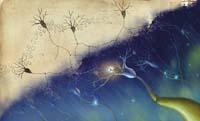Light to see the brain

Optogenetics is a valid technique to investigate brain activity and mental illness
Optogenetics, founded 4 years ago by physicist and bioengineer Karl Deiseroth, is already used in hundreds of laboratories around the world. In fact, it allows to see with great precision the activity of the brain and is not as hard as other techniques, since it is not necessary to place electrodes, for example.
This technique uses light to analyze brain activity. First they make light-sensitive neurons. To do this, they insert in the neurons the protein gene of a green algae. When neurons receive light through a fiber optic implant, they produce protein that turns on an electrical signal. The signal is transmitted to the next neuron within the circuit. Thus, researchers see much better the activity of neurons than with electrodes.
For example, at the University of London they used this technique to see how memories are kept in the brain of mice. According to the main model that explains how memories are created, when we learn a new association some neurons of the hippocampus are activated.
To demonstrate that this is so, the researchers genetically modified these neurons to produce protein with the effect of light. Then they taught the mice to be afraid of a sound: after hearing the sound they were given an electric shock. Thus, listening to the sound was enough to feel fear, and the neurons that produced that memory were activated (i.e., produced protein).
The next day, the researchers clarified the hippocampus with blue light. As a result, the neurons that participated in the creation of the memory on the eve were activated and the mice were frightened without hearing the sound. Thus they showed that yes, that memory occurs in the hippocampus.
In addition, the study of protein revealed the number of neurons involved in the formation of memories and demonstrated that they were much less than previously thought: They were only 100-200 (in this area of the hippocampus there are 1-2 million neurons).
In addition to seeing how memories occur, optogenetics is very useful for analyzing depression, Parkinson's and addictions. For example, in mice with depression, stimulating the prefrontal cortex, they have managed to improve social behavior and stimulate the desire to do things that can reward them.





